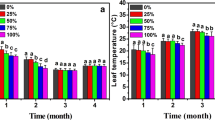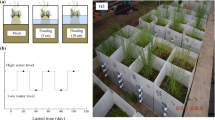Abstract
Locoweeds are defined as Astragalus and Oxytropis species that cause intoxication due to the alkaloid swainsonine. Swainsonine concentrations in Oxytropis sericea were influenced by location, plant part, and the developmental stage of the plant. Concentrations followed similar trends at each location, generally increasing over the growing season in above-ground parts until the plant reaches maturity with no change in concentration in the crowns. At the onset of senescence, swainsonine decreased in floral parts to less than half of the peak concentration. Similar to swainsonine concentrations, endophyte amounts were influenced by location, plant part, and the developmental stage of the plant. Likewise, endophyte amounts generally increased over the growing season in above ground parts and remained static in the crowns at all four locations. Swainsonine in Oxytropis sericea was positively associated with the endophyte Undifilum, which is responsible for swainsonine biosynthesis.




Similar content being viewed by others
References
Braun, K., Romero, J., Liddell, C., and Creamer, R. 2003. Production of swainsonine by fungal endophytes of locoweed. Mycol. Res. 107:980–988.
Cao, G. R., Li, S. J., Duan, D. X., Molyneux, R. J., James, L. F., Wang, K., and Tong, C. 1992. The toxic principle of Chinese locoweeds (Oxytropis and Astragalus): Toxicity in goats, pp. 117–121, in L. F. James, R. F. Keeler, P. R. Cheeke, E. M. Bailey Jr., and M. P. Hegarty (eds.), Poisonous Plants. Iowa State University Press: Ames, Iowa.
Colodel, E. M., Gardner, D. R., Zlotowski, P., and Driemeier, D. 2002. Identification of swainsonine as a glycoside inhibitor responsible for Sida carpinifolia poisoning. Vet. Hum. Toxicol. 44:177–178.
Colegate, S. M., Dorling, P. R., and Huxtable, C. R. 1979. A spectroscopic investigation of swainsonine: An alpha-mannosidase inhibitor isolated from Swainsona canescens. Aust. J. Chem. 32:2257–2264.
Cook, D., Ralphs, M. H., Welch, K. D., and Stegelmeier, B. L. 2009a. Locoweed poisoning in livestock. Rangelands. 31:16–21.
Cook, D., Gardner, D. R., Ralphs, M. H., Pfister, J. A., Welch, K. D., and Green, B. T. 2009b. Swainsonine concentrations and endophyte amounts of Undifilum oxytropis in different plant parts of Oxytropis sericea. J. Chem. Ecol. 35:1272–1278.
Cook, D., Gardner, D. R., Welch, K. D., Roper, J. M., Ralphs, M. H., and Green, B. T. 2009c. Quantitative PCR method to measure the fungal endophyte in locoweeds. J. Agric. Food Chem. 57:6050–6054.
Cook, D., Gardner, D. R., Grum, D. S., Pfister, J. A., Ralphs, M. H., Welch, K. D., and Green, B. T. 2011. Swainsonine and endophyte relationships in Astragalus mollissimus and Astragalus lentiginosus. J. Agric. Food Chem. 59:1281–1287.
Dantas, A. F. M., Riet-Correa, F., Gardner, D. R., Medeiros, R. M. T., Barros, S. S., Anjos, B. L., and Lucena, R. B. 2007. Swainsonine-induced lysosomal storage disease in goats caused by the ingestion of Turbina cordata in Northeastern Brazil. Toxicon 49:111–116.
Dreyer, D. L., Jones, K. C., and Molyneux, R. J. 1985. Feeding deterrency of some pyrrolizidine, indolizidine, and quinolizidine alkaloids towards pea aphid (Acyrthosiphon pisum) and evidence for phloem transport of indolizidine alkaloid swainsonine. J. Chem. Ecol. 11:1045–1051.
Gardner, D. R., and Cook, D. 2011. A comparison of alternative sample preparation procedures for the analysis of swainsonine using LC-MS/MS. Phytochem. Anal. 22:124–127.
Gardner, D. R., Molyneux, R. J., and Ralphs, M. H. 2001. Analysis of swainsonine: extraction methods, detection, and measurement in populations of locoweeds (Oxytropis spp.). J. Agric. Food Chem. 49:4573–4580.
James, L. F., and Nielsen, D. 1988. Locoweeds: Assessment of the problem on western U. S. rangelands. in L. F. James, M. H. Ralphs, and D. B. Nielsen (eds.), The ecology and economic impact of poisonous plants on livestock production (pp. 171–180). Westview Press, Boulder, CO.
Justus, M, Witte, L., and Hartmann, T. 1997. Levels and tissue distribution of loline alkaloids in endophyte-infected Festuca pratensis. Phytochemistry 44:51–57.
Keogh, R. G., Tapper, B. A., and Fletcher, R. H. 1996. Distribution of a fungal endophyte Acremonium lolii, and of the alkaloids lolitrem B and peramine, within perennial ryegrass. NZ J. Agric. Res. 39:121–127.
Kingsbury, J. M. 1964. Poisonous plants of the United States and Canada, pp 305–313. Prentice Hall, Englewood Cliffs, NJ.
Molyneux, R. J., and Gomez-Sosa, E. 1991. Presencia del alcaloide indolizidinico swainsonine en Astragalus pehuenches (Leguminosae - Galegueae). Bol. Soc. Argent. Bot. 27:59-64.
Molyneux, R. J., James, L. F. 1982. Loco intoxication: Indolizidine alkaloids of spotted locoweed (Astragalus lentiginosus). Science 216:190-191.
Molyneux, R. J., James, L. F., Ralphs, M. H., Pfister, J. A., Panter, K. E., and Nash, R. J. 1994. Polyhydroxy alkaloid glycosidase inhibitors from poisonous plants of global distribution: analysis and identification, pp. 107–112, in S. M. Colegate and P. R. Dorling (eds.), Plant-Associated Toxins, Agricultural, Phytochemical, and Ecological Aspects, CAB International, Wallingford, UK.
Molyneux, R. J., Mckenzie, R. A., O'Sullivan, B. M., and Elbein, A. D. 1995. Identification of the glycosidase inhibitors swainsonine and calystegine B2 in Weir vine (Ipomoea sp. Q6 [aff. calobra]) and correlation with toxicity. J. Nat. Prod. 58:878–886.
Oldrup, E., Mcclain-Romero, J., Padilla, A., Moya, A., Gardner, D. R., and Creamer, R. 2010. Localization of endophytic Undifilum fungi in locoweed seed and influence of environmental parameters on a locoweed in vitro culture system. Botany 88:512–521.
Pryor, B. M., Creamer, R., Shoemaker, R. A., Mcclain-Romero, J., and Hambleton, S. 2009. Undifilum, a new genus for endophytic Embellisia oxytropis and parasitic Helminthosporium bornmuelleri on legumes. Botany 87:178–194.
Ralphs, M. H. 1987. Cattle grazing white locoweed: influence of grazing pressure and palatability associated with phenological growth stage. J. Range Manage. 40:330–332.
Ralphs, M. H., Cook, D., Gardner, D. R., and Grum, D. S. 2011. Transmission of the locoweed endophyte to the next generation of plants. Fungal Ecol. 4:251–255.
Ralphs, M. H., Creamer, R., Baucom, D., Gardner, D. R, Welsh, S. L., Graham, J. D., Hart, C., Cook, D., and Stegelmeier, B. L. 2008. Relationship between the endophyte Embellisia Spp. and the toxic alkaloid swainsonine in major locoweed species (Astragalus and Oxytropis). J. Chem. Ecol. 34:32–38.
Ralphs, M. H., Graham, D, and James, L. F. 1994. Cattle grazing white locoweed in New Mexico: influence of grazing pressure and phonological growth stage. J. Range Manage. 47:270–274.
Ralphs, M. H., Graham, D, Molyneux, R. J., and James, L. F. (1993). Seasonal grazing of locoweeds by cattle in northeastern New Mexico. J. Range Manage. 416–420.
Rottinghaus, G. E., Garner, G. B., Cornell, C. N., and Ellis, J. L. 1991. HPLC method for quantitating ergovaline in endophyte-infested tall fescue: seasonal variation of ergovaline levels in stems with leaf sheaths, leaf blades, and seed heads. J. Agric. Food Chem. 39:112–115.
Wang, Q., Nagao, H., Li, Y., Wang, H., and Kakishima, M. 2006. Embellisia oxytropis, a new species isolated from Oxytropis kansuensis in China. Mycotaxon 95:255–260.
White, T. J., Bruns, T., Lee, S., and Taylor, J. 1990. Amplification and direct sequencing of fungal ribosomal RNA genes for phylogenetics, pp. 315–322, in M. A. Innis, D. H. Gelfand, J. Sninsky and T. J. White (eds.). PCR Protocols: a guide to methods and Applications. Academic Press, San Diego, CA.
Young, C. A., Bryant, M. K., Christensen, M. J., Tapper, B. A., Bryan, G. T., and Scott, B. 2005. Molecular cloning and genetic analysis of a symbiosis-expressed gene cluster for lolitrem biosynthesis from a mutualistic endophyte of perennial ryegrass. Mol. Gen. Genomics 274:13–29.
Acknowledgements
We thank Jessie Roper, Clint Stonecipher, and Scott Larsen for technical assistance.
Author information
Authors and Affiliations
Corresponding author
Electronic Supplementary Material
Below is the link to the electronic supplementary material.
ESM 1
(DOC 69 kb)
Rights and permissions
About this article
Cite this article
Cook, D., Shi, L., Gardner, D.R. et al. Influence of Phenological Stage on Swainsonine and Endophyte Concentrations in Oxytropis sericea . J Chem Ecol 38, 195–203 (2012). https://doi.org/10.1007/s10886-012-0067-0
Received:
Revised:
Accepted:
Published:
Issue Date:
DOI: https://doi.org/10.1007/s10886-012-0067-0




